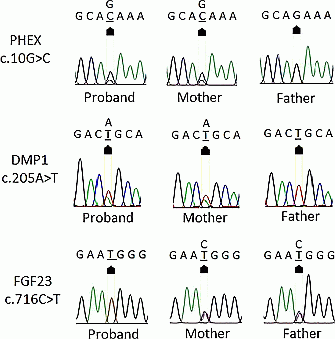ICCBH2015 Poster Presentations (1) (201 abstracts)
PHEX, DMP1 and FGF23 mutations in a Malaysian hypophosphatemic rickets patient
Nurul Nadirah Razali 1 , Tzer Hwu Ting 2 & Karuppiah Thilakavathy 1,
1Department of Obstetrics and Gynaecology, Department of Paediatrics, Clinical Genetics Unit, Universiti Putra Malaysia, UPM Serdang, Selangor, Malaysia; 2Department of Paediatrics, Universiti Putra Malaysia, UPM Serdang, Selangor, Malaysia; 3Genetics and Regenerative Research Centre, Universiti Putra Malaysia, UPM Serdang, Selangor, Malaysia.
Hypophosphatemic rickets (HR) is a type of bone disorder that causes skeletal deformities due to reduced renal phosphate reabsorption that affect bone mineralisation. Defect on PHEX, DMP1 and FGF23 causes x-linked dominant, autosomal recessive and autosomal dominant HR respectively. The aim of this study was to identify the underlying genetic mutations in PHEX, DMP1 and FGF23 in a 15-year-old female who exhibits the clinical features of HR that was confirmed by laboratory tests and radiological assessment. The parents and her two other siblings did not show any clinical symptoms of HR. Genetic variations in these genes were assessed using polymerase chain reaction and direct sequencing of coding exons and flanking intronic regions. The proband was found to have mismatch mutations in all three genes leading to amino acid changes at c.10G>C, (p.E4Q), c.205A>T (p.S69C), and c.716C>T (p.T239M) in PHEX, DMP1 and FGF23 respectively (Figure 1). Based on SIFT and PolyPhen, tools that predict functional impact of amino acid changes, E4Q mutation in PHEX was evaluated as tolerable and probably damaging respectively. The tools predicted the mutation found in DMP1 (S69C) as damaging and probably damaging, while T239M mutation in FGF23 as tolerable and benign respectively. E4Q and S69C mutations had been reported to affect bone mineralisation and causes hypophosphatemia in HR patients1,2, while T239M mutation has been linked to renal phosphate leak in hypophosphatemic nephrolithiasis3. The presence of three mutations in genes related to HR probably was the reason for severe clinical manifestations of HR in this patient. The molecular diagnosis confirmed the clinical diagnosis of HR in this patient and contributes significantly to genetic counselling and helps improve patient clinical care and management.
Disclosure: The authors declared no competing interests.
References: 1. St-Louis M. Contrôle de l’expression de la protéine PHEX et rôle de PHEX et FGF23 dans la minéralisation par les cellules MC3T3. Doctoral dissertation. Université de Montréal, Quebec, Canada. 2009.
2. Turan S, Bastepe M, Bereket A, et al. Identification of Novel Dentin Matrix Protein-1 (DMP1) Mutations in Two Unrelated Kindreds with Autosomal Recessive Hypophosphatemia. SABMR 29th Annual Meeting. Journal of Bone and Mineral Research, 2007 22: 402–451. doi: 10.1002/jbmr.5650221410.
3. Rendina D, Esposito T, Mossetti G, et al. A functional allelic variant of the FGF23 gene is associated with renal phosphate leak in calcium nephrolithiasis. The Journal of clinical endocrinology and metabolism, 2012 97(5): E840–4. doi:10.1210/jc.2011-1528.

Figure 1 Mutation analysis of PHEX, DMP1 and FGF23 of a Malaysian family with hypophosphatemic rickets daughter. The proband was heterozygous for PHEX (c.10GOC, > p.E4Q) and DMP1 (c.205AOT, > p.S69C), and homozygous for FGF23 (c.716COT, > p.T239M) missense mutations. Her unaffected mother had both the mutant and wild-type alleles for all the mutations. The asymptomatic father carried homozygous wildtype allele, homozygous mutant allele and heterozygous alleles for PHEX, DMP1 and FGF23 respectively.




